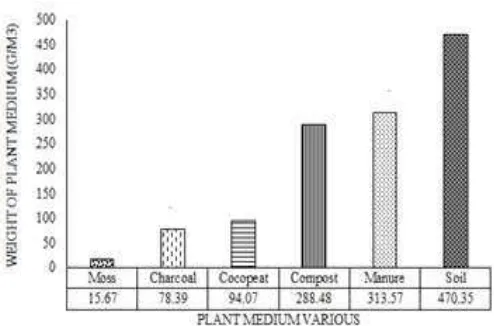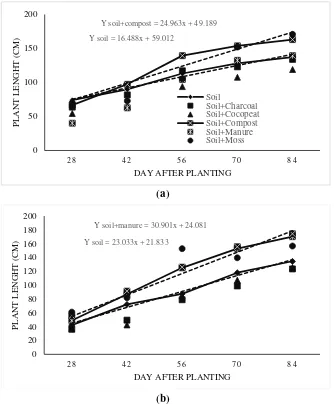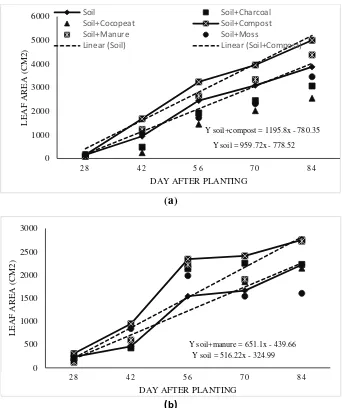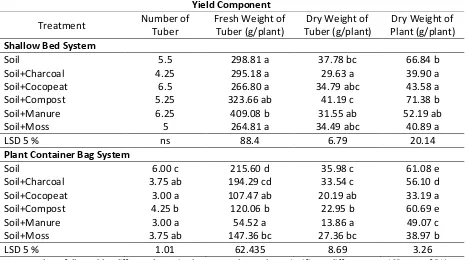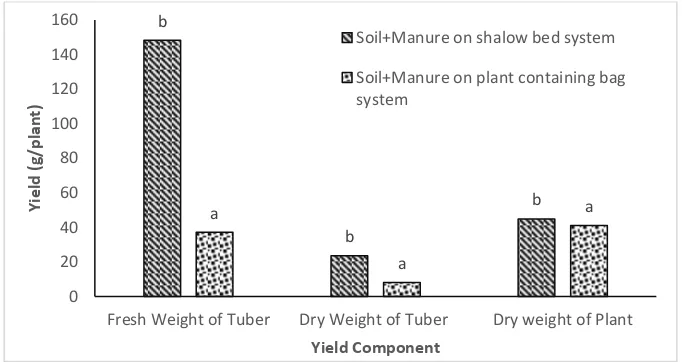Use of Six Planting Media on Shallow Bed and Plant Container Systems to The
Growth and Yield of Sweet Potato
(Ipomoea batatas
L.) for Roof Garden
Sitawati*), Agus Suryanto and Euis Elih Nurlaelih
Department of Agronomy, Faculty of Agriculture, University of Brawijaya email: [email protected]
ABSTRACT
Roof garden is an alternative to overcome food security through breeding crops and horticultures of fruits and vegetables. Research aimed to determine the yield of sweet potatoes that planted through various planting medium on roof garden by using shallow bed and plant container bag system. The research was conducted in Malang by applying two planting systems, such as shallow bed (direct cropping) and plant container bag on the same planting medium. Randomized Block Design (RBD) with six treatments of planting medium and four replications was adopted in this experiment. Six planting media were 1) Soil only, 2) Soil + Charcoal, 3) Soil + Cocopeat, 4) Soil + Compost, 5) Soil + Manure, and 6) Soil + Moss. Each combination of soil was one to one (1:1). Analysis of Variance (ANOVA), Least Significant Difference (LSD) and T-test were used at 5% for each to examine data. Length of crop, leaf area, numbers of tuber, fresh weight of tuber, dry weight of tuber, and total dry weight of plants were observed variables. Results showed that the application of soil and manure (1:1) as planting medium for shallow bed system on roof garden concept increased numbers of tuber, fresh weight of tuber, dry weight of tuber, and dry weight of Sweet Potato (Ipomoea batatas L.) compared to container bag system with the same planting medium. Keywords: charcoal; manure; soil; planting system.
INTRODUCTION
stored in the growing medium temporarily, and will be taken up by the plants and returned to the atmosphere through evapotranspiration. In addition, rooftop gardens can provide additional green space in urban areas, and increase property values. Moreover, roof garden may overcome food security through crop breeding, as well as horticultural farming, such as fruits and vegetables.
Sweet potato is one of important crops and agricultural commodities, which contains of carbohydrate. Sweet potato has an important role as food reserves instead of rice and maize. Sweet potato has greater opportunity due to its high consumption level, whereas it is consumed by almost population in Indonesia. At the suburban areas in Indonesia, sweet potato is considered as secondary staple food, while at the urban areas, sweet potato has been processed into crispy chips and other snacks for industrial interests. Sweet potato contains higher content of starch, sugars, proteins, vitamin C, ascorbic acid as well as phosphorus, calcium and magnesium (Krochmal-marczak et al., 2014). Sweet potatoes can help reducing nutritional problems and can be especially recommended for diabetics (Krochmal-marczak et al., 2014). Therefore, sweet potato is highly potential to be developed.
Existence of such roof garden may increase the load. Piles of soil and plants may increase the material loads, wind load, and additional load of water on roof of the buildings (Nayeem, 2014). Soil is usually used as planting medium for the sweet potato. However, the use of soil as planting medium for sweet potato on the roof garden may burden structure and construction of the roof, so that it requires lightweight growth medium as an alternative in order to produce higher productivity of the sweet
potato. Sweet potato can be grown in containers, but the space for the tubers is more restricted than in the shallow beds, but the advantage is the optimum use of the nutrients (Boland, 2005). A shallow bed consists of a thin layer of soil that is regularly watered, preferably with direct sunlight and a good growing medium. Extensive roof gardens are established with mineral
gro i g edia, the first are pri aril
important in areas with poor precipitation (Oberndorfer et al., 2007). An extensive roof garden can retain storm water and allow its gradual run-off from the roof. Thus, good drainage should be concerned in the roof garden to produce optimal plant growth. The hypothesis of this research was the use of soil and manure (1:1) by shallow bed system on roof garden concept could increase the yield of sweet potato (Ipomoea batatas L.).
MATERIALS AND METHODS
Figure 1. Weight of each planting medium on roof garden
Two planting systems, such as shallow bed (direct planting) on the first experiment and container bag for the second experiment were adopted for six types of planting medium. Randomized Block Design (RBD) was adopted for both planting systems. There was six types of planting medium and four replications, i.e.: soil medium only, and five combinations of soil. Five combinations of soil were soil and charcoal, cocopeat, compost, manure, and moss with composition for each one to one (1:1).
There were some observed variables in
this e peri e t. It’s ere le gth of pla t, leaf
area, number of tuber, fresh weight of tuber, dry weight of tuber, and total dry weight of plant. Analysis of variance (ANOVA) was used to analyze data. If there were found significance, the Least Significant Difference (LSD) test at 5% is used. T-test was also used to compare between shallow bed and container bag systems.
RESULTS AND DISCUSSIONS
The results showed that media composition influenced the length of sweet potato plants (Figure 2). On shallow bed and container bag plant systems, the treatment of soil + compost has a higher sweet potato length than soil media, soil + cocopeat and soil + charcoal husk. At 84 days after planting (dap),
the length of sweet potato plant on soil + compost has the same yield as on soil + manure and soil + moss. Application of compost contained organic material can improve soil conditions. In addition, the compost is leaf litter, as well as animal feces that have undergone the decomposition process by decomposing microorganisms, so it can be utilized to improve soil properties and can accelerate the rate of plant growth
Compost has adequate nutrients, which
i rease the pla t’s gro th to e opti al.
Compost contains more microorganisms and the application of additional compost into the soil may trigger the microorganism to develop and produce much CO2 (Arslan et al., 2008),
which will be used for photosynthesis, so that the plants will grow faster. The available nitrogen will be absorbed by the roots and it will promote the formation of vegetative parts faster due to the meristem tissues have cellular division, elongation and enlargement of new cells, as well as protoplasm, so that the plant will grow optimal (Näsholm et al., 2009).
Y soil = 23.033x + 21.833
Y soil+manure = 30.901x + 24.081
0 20 40 60 80 100 120 140 160 180 200
2 8 4 2 5 6 7 0 8 4
P
L
A
NT
L
ENG
HT
(CM
)
DAY AFTER PLANTING leaf areas of the sweet potato by the
application of soil + compost and soil + manure did not show any significant difference with the application of soil, soil + cocopeat and soil + charcoal, but they showed significant difference by the application of soil + moss (Figure 3). The increasing leaf area due to the increasing numbers of leaf may be related the competition to intercept light among leaves (Craine and Dybzinski, 2013). During the observation, leaf area increases due to the increasing formation of new leaves and numbers of leaf, which are proportionate to the increasing leaf area. Nitrogen is one of essential elements for the plant growth, which
is mostly required for formation and development of vegetative parts of the plant, such as leaf, stem, and root (Zong-Min et al., 2012). Furthermore, the application of organic materials may improve physical, chemical, and biological properties of the soil (Gulyás and Füleky, 2013). It is due to organic materials have nutritional functions, in which organic material is one of nutrient sources for plants, such as N, P, K and S; biological function refers
to trigger orga is ’s a ti ities i the soil; a d
physical function refers to form excellent structure that will improve aeration and drainage in the soil.
(a)
(b)
Figure 2. Length of Sweet Potato (Ipomoea batatas L.) crop on Roof Garden by Shallow Bed System and Plant Container Bag System
Y soil = 16.488x + 59.012
Y soil+compost = 24.963x + 49.189
0 50 100 150 200
2 8 4 2 5 6 7 0 8 4
P
L
A
NT
L
ENG
HT
(CM
)
DAY AFTER PLANTING Soil
(a)
(b)
Figure 3. Leaf Area of Sweet Potato (Ipomoea batatas L.) on Roof Garden by Shallow Bed System (a) and Plant Container Bag System (b)
Results of the research on shallow bed system showed that the application of diverse planting mediums affected on fresh weight and dry weight of tubers per plant (Table 1). Fresh weight of tubers per plant by the treatment of soil + manure showed higher yield than the treatment of soil + cocopeat, soil + moss and soil, but fresh weight of tuber by the treatment of soil + manure was comparable to fresh weight of tuber by the treatment of soil + charcoal and soil + compost, but if it is observed in accordance with lighter weight of planting medium, soil + charcoal is considered as
lighter medium and has requirements for optimal growth and development of the plant. Planting medium of soil + charcoal has higher fresh weight of tuber and dry weight of tuber in comparison with other lighter planting mediums, such as: soil + cocopeat and soil + moss. Charcoal medium has better air circulation, easily bind the water and uneasily to be in clumps.
Fresh weight of total plants by the treatment of soil + manure showed higher yield than other treatments, but fresh weight of total plants by the treatment of soil + manure did not show significant
Y soil = 959.72x - 778.52 Y soil+compost = 1195.8x - 780.35
0 1000 2000 3000 4000 5000 6000
2 8 4 2 5 6 7 0 8 4
L
EA
F
A
REA
(CM
2
)
DAY AFTER PLANTING
Soil Soil+Charcoal
Soil+Cocopeat Soil+Compost
Soil+Manure Soil+Moss
Linear (Soil) Linear (Soil+Compost)
Y soil = 516.22x - 324.99 Y soil+manure = 651.1x - 439.66
0 500 1000 1500 2000 2500 3000
2 8 4 2 5 6 7 0 8 4
L
EA
F
A
REA
(CM
2
)
difference with fresh weight of total plants by the treatment of soil + compost. Therefore, it can be said that sweet potato contains different water content and element. It was due to treatment of different medium may create different absorption of water and photosynthate partition. Fresh weight is affected by water content in cells of the plant, in which the levels are affected by environmental factors,
such as temperature and humidity, while dry weight of the plant is more referred to status of the pla t’s gro th (Kusumaningrum et al., 2007). Dry weight of total plants showed that the treatment of different mediums affected on dry weight of sweet potato. It showed that the accumulation of organic compounds which synthesized by the plants among treatments were different.
Table 1. Yield Component of Sweet potato in Order to Increase the Yield of Sweet Potato (Ipomoea batatas L.) through Different Types of Planting Medium on Roof Garden by the Application of Plant
Container Bag System
Yield Component
Treatment Number of
Tuber
Fresh Weight of Tuber (g/plant)
Dry Weight of Tuber (g/plant)
Dry Weight of Plant (g/plant)
Shallow Bed System
Soil 5.5 298.81 a 37.78 bc 66.84 b
Soil+Charcoal 4.25 295.18 a 29.63 a 39.90 a
Soil+Cocopeat 6.5 266.80 a 34.79 abc 43.58 a
Soil+Compost 5.25 323.66 ab 41.19 c 71.38 b
Soil+Manure 6.25 409.08 b 31.55 ab 52.19 ab
Soil+Moss 5 264.81 a 34.49 abc 40.89 a
LSD 5 % ns 88.4 6.79 20.14
Plant Container Bag System
Soil 6.00 c 215.60 d 35.98 c 61.08 e
Soil+Charcoal 3.75 ab 194.29 cd 33.54 c 56.10 d
Soil+Cocopeat 3.00 a 107.47 ab 20.19 ab 33.19 a
Soil+Compost 4.25 b 120.06 b 22.95 b 60.69 e
Soil+Manure 3.00 a 54.52 a 13.86 a 49.07 c
Soil+Moss 3.75 ab 147.36 bc 27.36 bc 38.97 b
LSD 5 % 1.01 62.435 8.69 3.26
Notes : numbers followed by different letter in the same column show significant difference on LSD test of 5% on standard error 5%; ns = not significant
Table 1 showed that types of planting medium do not affect on number of tuber against the shallow bed system, but significantly affect on number of tuber by the application of plant container bag system. The planting medium types affect on fresh weight of tuber, dry weight of tuber, and dry weight of plant by the application of shallow bed system and plant container bag system. Number of tuber, on plant container bag system and soil medium, showed higher
medium. It is due to charcoal may increase charcoal, therefore the potential roots that will become tuber, could pass through the soil optimally. Moss is more fibrous because it has been mixed with soil, so that the roots will be difficult to pass through the soil and it would produce deeper concave tuber. Relatively high weight of soil in comparison with other planting mediums was due to soil capacity in absorbing water and greater aggregate mass of the soil. Verticultural breeding, light medium that can be used as alternative to reduce the load is combination between compost and soil, soil and moss, as well as soil and charcoal (Kuhn and Peck, 2003). Temperature of planting comparison with other medium. Besides that, temperature of the medium may affect on the tuber growth. Soil + charcoal has the lowest temperature in comparison with other medium compositions, but it does not make growth and development of the tuber to be more optimal. Types of media influence the fresh weight and number of leaf for crop (Sitawati et al., 2016). It was due to contents of the medium affect on the tuber formation. Each medium has different content, so that the tuber may absorb
different nutrients as well. Besides that, if it is compared with light planting medium, substitutes soil, which could store water and has lower temperature than the soil. Meanwhile, soil has heavier weight and higher temperature, due to weight of the soil volume may affect porous space of the soil and tend to have higher temperature. Improper temperature may inhibit the growth of root and apex radicis may have different form due to branching may keep growing to the apex radicis, so that the movement space for the tuber growth will be difficult or inhibited. The roof garden may functions to reduce runoff and air contaminant filter, as well as aesthetic purpose (Hastuti and Anggraini, 2010).
weight of plant reflects accumulation of organic compounds, which is synthesized from inorganic compounds, particularly water and carbon dioxide. The absorbed nutrients may contribute in increasing dry weight of plant. Dry weight of plant is a result of efficiency in absorbing and utilizing sun radiation, which is available during the planting period by canopy of the plant (Kastono et al., 2005). Soil + manure contain much water in comparison with other medium. Manure is source of macronutrients and micronutrients for plants. However, based on light planting medium, soil + moss have low values for fresh and dry weights of tuber. Moss is dry moss, which is used to substitute soil or fiber for orchids and marcottage plant (Muhit, 2010). Moss, which is usually used as planting medium, is derived from ferns that are mostly found in forests. Moss is mostly used as planting medium from nursery period to flowering period. Such medium is porous, which enables the roots to grow freely. According to its properties, moss medium affords to bond water and well drainage and aeration systems. Dry weight of plant is a result of efficiency in absorbing and utilizing sun radiation, which is available during the planting period by canopy of the plant (Kastono et al., 2005). At 105 daps, fresh weight of tuber per plant showed similar yield, in which the highest values were obtained by the treatment of soil + manure, whereas the highest yield of dry weight of tuber per plant were obtained by the application of soil + compost.
Results of observation on shallow bed showed big to medium sizes and oval shape; on soil + charcoal, the yield of tuber showed big and round shape; on soil + cocopeat, the tuber has medium and round shape. The treatment of soil + compost produced medium and oval tubers; soil + manure produced small and round tuber; and soil + moss produced cylindrical tuber. Soil has solid structure, so that it may affect the
tu er’s shape, ig a d o al. Moss is porous,
which enables the roots to grow and develop freely, but by the application of soil + moss, the yield of tuber has cylindrical shape due to the medium has been mixed with soil, so that soil + moss become fibrous and it makes the roots have difficulty to penetrate the becomes loose and it will increase ability of the soil to absorb water. Therefore, the roots will easily penetrate the medium and produce round and big tubers.
Fresh weight and dry weight of total plants showed significant difference of yield among treatments. Fresh weight is affected by water content in cells of the plant, which is affected by environment, such as temperature and humidity, so that dry
eight of pla t sho s status of the pla t’s
Results of observation on total fresh weight at 105 daps showed that the composition of soil + manure, on average, has the highest values in comparison with other medium. Organic materials were derived from three sources, such as manure, green manure, and remains of the planted greeneries. Manure is the source of macronutrients and micronutrients. Total dry weight of the sweet potato, during observation at 105 daps, showed the highest values, on average, by the composition of soil + compost, in comparison with other mediums. It is due to the application of soil + compost has the fastest and highest vegetative growth. Vegetative growth may affect on total dry weight of the plant (Rahayu, 2006).
The application of soil + manure produced the highest yield compared to other planting media. The application of
soil + manure on different planting systems, shallow bed and plant container bag, on roof garden has provided different yields as well, in which the application of soil + manure on shallow bed system has produced higher yield for fresh weight of tuber, dry weight of tuber, and dry weight of plant in comparison with the application of soil + manure on plant container bag system (Figure 4). Compositions of soil + manure, which were applied in this research, have decomposition process. In general, the application of organic fertilizer is intended to regain nutrients, improve soil structure, and increase organic materials in the soil. Manure has some benefits, for example, it could restore soil fertility by improving physical, chemical, and biological properties of the soil (Berry, 2015).
Figure 4. Yield Component of Sweet Potato in order to Increase Yield of Sweet Potato (Ipomoea batatas L.) through Different Types of Planting Medium on Roof Garden by the Application of Shallow Bed System and Container Bag Planting System. (a) Shallow bed system, (b) plant container bag system at 140 daps.
CONCLUSIONS
The application of soil and manure (1:1) through shallow bed system by the concept of Roof Garden could increase number of tuber, fresh weight of tuber, dry weight of
tuber, and dry weight of sweet potato (Ipomoea batatas L.) plant in comparison with the application of soil and manure (1:1) on plant container bag system.
b
b
b a
a
a
0 20 40 60 80 100 120 140 160
Fresh Weight of Tuber Dry Weight of Tuber Dry weight of Plant
Yi
e
ld
(
g
/p
lan
t)
Yield Component
ACKNOWLEDGEMENT
Research was funded by Indonesian Directorate General of Higher Education. Authors thank to Dewi Ratih R. D., Zahra Fitria and Suci for their contribution in the writing and preparing of paper.
REFERENCES
Afroz, R. 2016. Impact of green roof on urban canopy layer microclimates in planned residential area of Dhaka, Bangladesh. BANGLADESH UNIVERSITY OF ENGINEERING AND TECHNOLOGY. Arslan, E. I., E. Öbek, S. K. Ğ, U.İ. Pek, a d M.
Topal. 2008. Determination of the Effect of Compost on Soil Microorganisms. Int. J. Sci. Technol. 3(2): 151–159.
Badan Pusat Statistik. 2014. Persentase Penduduk Daerah Perkotaan menurut Provinsi, 2010-2035. : 1 Available at https://www.bps.go.id/linkTabelStatis /view/id/1276.
Berry, L. 2015. Manure Testing: Benefits and Rationale.: 1–2. Available at Directions in Green Roof-Research Green Roof Research in British Columbia-An Overview. In Greening rooftops for sustainable communities. greening rooftops for sustainable communities, Washington DC.
Craine, J. M., and R. Dybzinski. 2013. Mechanisms of plant competition for nutrients, water and light. Funct. Ecol. 27(4): 833–840.
Gulyás, M., and G. Füleky. 2013. Effects of biogas digestate on soil properties and plant growth. EGU Gen. Assem. 2013 15 (March): EGU2013-2797 Available at
http://adsabs.harvard.edu/abs/2013E GUGA.15.2797G.
Harwati, C. T. 2008. Pengaruh suhu dan panjang penyinaran terhadap umbi kentang. Innofarm 7(1): 11–18. Available at http://www.ejurnal.unisri. ac.id/index.php/innofarm/article/view/ 233.
Hastuti, E., and F. Anggraini. 2010. Studi taman atap didalam retensi air hujan. Lingkung. Trop. 4(1): 31–40.
Kastono, D., H. Sawitri, and Siswandono. 2005. Pengaruh Nomor Ruas Setek Dan Dosis Pupuk Urea Terhadap Pertumbuhan Dan Hasil Kumis Kucing. Ilmu Pertan. 12(1): 56–64.
Krochmal-marczak, B., B. Sawicka, J. Supski, T. Cebulak, K. Paradowska, and S. Available at http://www.cmhc.ca/en/ inpr/bude/himu/coedar/loader.cfm?u rl=/commonspot/security/getfile.cfm &PageID=70146.
Kusumaningrum, I., R. B. Hastuti, and S. Haryanti. 2007. Pengaruh Perasan Sargassum crassifolium dengan Konsentrasi yang Berbeda terhadap Pertumbuhan Tanaman Kedelai (Glycine max (L) Merill). J. Bul. Anat. dan Fisiol. 15(2): 17–22.
Available at http://onlinelibrary.wiley. com/doi/10.1111/j.1469-8137.2008. 02751.x/full.
Nayeem, B. 2014. Implication of building
attri utes to o pe sator gree : A
case study of residential building in Dhaka city. Proc. 5th Int. Conf. Environ. Asp. Bangladesh: 43–45.
Oberndorfer, E., J. Lundholm, B. Bass, R.R. Coffman, H. Doshi, N. Dunnett, S. Gaffin, M. Köhler, K.K.Y. Liu, and B. Rowe. 2007. Green Roofs as Urban Ecosystems: Ecological Structures, Functions, and Services. Bioscience 57(10): 823–833. Available at http://academic.oup.com/ bioscience/article/57/10/823/232363/ Green-Roofs-as-Urban-Ecosystems-Ecological.
Prameswari, Z., S. Trisnowati, and S. Waluyo. 2014. Pengaruh Macam Media dan Zat Pengatur Tumbuh Terhadap Keberhasilan Cangkok Sawo
(Manilkara zapota (L.) van Royen) pada Musim Penghujan. Vegetalika 3(4): 107–118.
Rahayu, M. 2006. Vegetative growth of upland rice and some pineapple varieties in intercropping at dryland Gunung Kidul, Yogyakarta. Biodiversitas, J. Biol. Divers. 7(1): 73–76. Available at http://biodiversitas.mipa.uns.ac.id/D/ D0701/D070118.pdf.
Sitawati, A. Suryanto, and E. E. Nurlaelih. 2016. Optimization of Plant Growth and Yield Through Innovation of the Verticultural Materials and Media. RJLS 3(1): 55–64.
